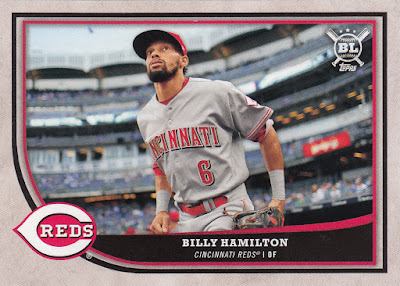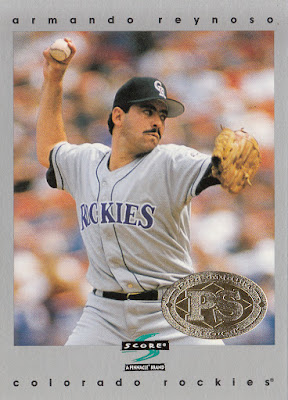Now that I'm caught up on trade posts, my next project is going through all the blasters that have been accumulating on the same shelf. Most of those have been from 2020, but I have a stack of Topps Big League going back to the brand's inception in 2018 that has just been sitting there.
It would be more accurate to say that Topps Big League replaced Topps BUNT, the physical manifestation of their digital app. An app, by the way, that I spent way too much time on this weekend. Regardless of what they call it, this is the low-priced, youth-focused set that occupies the market segment that Triple Play and UD Fun Pack held back when I was a kid.
That means affordability, small-ish set sizes, entertaining photographs, and fun facts on the back that may or may not be tangentially related to the actual sport of baseball.
 |
| 2018 Topps Big League #281 Ketel Marte |
Even when I'm not leading off with a Rockies card, the NL West is well-represented. This is Ketel Marte of the Diamondbacks, doing some pre-game warmups with Orbit, the lovable mascot of the Houston Astros. Usually you have to find Opening Day to add mascot cards to your collection, but Big League put it right in the base set. There is one Topps flagship card with a mascot that comes to mind, but it's quite rare. This photo is not going to be on the cover of Sports Illustrated, but it sets a lighthearted tone nonetheless.
Marte's card back calls him "a high-energy performer with good speed." It also mentions that he had two triples in the 2017 NL Wild Card game, part of what ended the 2017 Rockies season earlier than I would have liked. There were two additional triples that game, one by pitcher Archie Bradley, and another by A.J. Pollock.
Yes, yes, I know. COORS. That game was played in Arizona.
Regardless, Marte kept right on going in the 2018 season, leading the Big Leagues with twelve triples. Warming up with Orbit is always a good decision. Just look at those little baseballs on the end of the antennae.
 |
| 2018 Topps Big League #226 Ichiro |
Ichiro is one of those guys that never has a bad card. Not that there are many bad cards out there in this day and age, but he never even has mediocre ones. If they don't show a great action shot, then it's an awesome landscape or wide-angle shot like this. Or this. Everywhere he went, he had mobs of adoring fans from all walks of life and fandoms. Here, I see fans with apparel from the Mariners, Nationals, Royals, Dodgers, Red Sox, Twins, and even the Chicago Bears. I particularly like the giant photo a fan is holding out toward him with two big blue arrows directing him where to sign, as though he hasn't been doing this kind of thing for decades.
 |
| 2018 Topps Big League #195 Yolmer Sánchez |
With or without a pitch clock, baseball does involve waiting around. Of course, for that patience, you're occasionally rewarded with a roller coaster of a game like we saw Saturday in Game 4 of the World Series. But it's a strategic game with time to plan your moves, so no matter what rule changes come at us over the next few years, you can be sure players will still be chewing bubble gum out there on the diamond.
And as long as that happens, I hope baseball card companies aren't afraid to give us cards of players blowing bubbles. It's certainly less problematic than showing players with a big wad of chewing tobacco, especially for a youth-oriented set. And based on what the back tells us about Yolmer Sánchez, who is described on the back as a "fun-loving prankster", this is a perfect card.
 |
| 2018 Topps Big League #370 Lourdes Gurriel Jr. (RC) |
This one is more of a typical card photo, but the memorial patch on Lourdes Gurriel Jr.'s left sleeve caught my eye. The Blue Jays wore that #32 patch in 2018 for Roy Halladay, who passed away in November 2017. Some might remember him as a Phillie, since that's the only team he saw Postseason action with, but he spent most of his career as a Toronto Blue Jay.
You still get to see the Rookie Card logo from time to time in a brand like this, although most collectors will probably consider his true Rookie Card to be #US110 from 2018 Topps Update. Even with a Topps monopoly, the RC logo isn't completely reliable.
Overall, 2018 Big League is a simple but effective design. There are color-coded border accents that don't intrude on the photo. The player's name, team, and position are all in the same small area, and they're a bit on the small side but still easily legible. Again, youth-oriented. The team logo is perhaps bordering on a bit too large, but nothing obnoxiously out of hand like 2010 Topps. And it's foil-free at this price point, which leads to a surprisingly detailed Big League logo in the upper right.
Gurriel's fun fact tells us about his whole baseball family in Cuba, as well as his brother Yuli who plays with Orbit for the Astros. That got me thinking about Cuban players in general, and how many players never got their shot in the MLB due to the geopolitical tensions between the USA and Cuba. As with Japanese players, there were one or two that debuted back in the 1960s, but you didn't see players of either nationality get a shot in the MLB until the mid-'90s.
Just add it to the list of the many what-ifs that are peppered throughout baseball history.
 |
| 2018 Topps Big League #293 Carlos González |
That hasn't been quite as much the case with Venezuelan players. The first Venezuelan Big Leaguer played in 1939, and you'll certainly know the name Luis Aparicio, the country's first Hall of Famer who debuted in 1956.
Similarly, Carlos González and Yolmer Sánchez are fellow countrymen, but only one of them is likely to enter my Coors Field frankenset. Sánchez could up his chances significantly if he joined an NL West team. Actually, he did sign with the Giants for 2020, but the shortened season meant he never got playing time there and just signed right back with the White Sox.
As I scan these, I'm noticing how CarGo's bat peeks out of the frame all the way to the top of the card, always a nice design touch. Gurriel's card didn't do that, so there's a little inconsistency on the design front in that regard.
As this is a rather common set, I've seen it arrive in trades several times. Mostly I've just mixed them in to the blaster pile, so if you sent me cards from this set, they may have been intermingled into this stack over the past couple years. Entropy and all, you know. I don't catalog my cards nearly as accurately as some of you do, so this CarGo card could have been from the blaster, or from one of my many trading partners.
The trade posts are the catalog, I suppose.
 |
| 2018 Topps Big League #210 Billy Hamilton |
Billy Hamilton, then with the Reds, is the first USA-born player to appear in today's post, and he looks somewhat humbled to be playing in Yankee Stadium. The recognizable upper facade has appeared on many, many cards throughout the years, and I'm glad to see Topps keep the tradition going, even though it's technically a new stadium now.
His hitting leaves a bit to be desired, but Hamilton is known throughout the league for his speed. Near the end of the 2020 regular season, he stole home, something that Manuel Margot just unsuccessfully tried in Game 5.
Gutsy play, though.
 |
| 2018 Topps Big League #145 Carlos Carrasco |
Cleveland did make it to the Postseason this year, although they were dispatched in short order by the Yankees. Carlos Carrasco started their second game, but things fell apart for the Indians late that day. He'll surely be back for another season in 2021, hurling two-seam fastballs as pictured on this horizontal card.
"Cookie", another Venezuelan, has been with the Indians for his whole 11-year career, although he lost a lot of time in 2019 fighting leukemia. In fact, in looking through this stack of cards, I was pretty surprised at how many of these guys have had to deal with cancer.
 |
| 2018 Topps Big League #44 Trey Mancini |
Trey Mancini has had his own battle to fight. Shortly before turning 28 during this year's dicey spring training, he was diagnosed with stage-III colon cancer. That's a scary thing to happen, especially at such a young age, and he wrote all about his experience in The Player's Tribune.
The 2020 season, in whatever form it was going to take, passed him by, but I hope to see him and Carrasco facing off against each other next season.
 |
| 2018 Topps Big League #4 Jon Lester |
Cancer is further in the past of a few players, such as Jon Lester. It depends on a lot of factors, but treatments for many forms of the disease are becoming more effective. Lester's battle involved a fight with non-Hodgkin's lymphoma back in his rookie year. He's had a long and successful career since then, and pitched Game 4 of the 2007 World Series, the day after I had my own chance to witness such a historic game.
Incidentally, I recently found out that Game 3 in 2007 marked the first time that two Japanese-born players appeared on opposing teams in a single World Series. Boston's Game 3 starter was Daisuke Matsuzaka, and the Rockies had Kaz Matsui on their roster.
 |
| 2018 Topps Big League #59 Jameson Taillon |
Even with the havoc that coronavirus has wrought on the 2020 season, Jameson Taillon wasn't going to pitch in 2020 anyway. He's recovering from Tommy John surgery, which he underwent in 2019. But before that, he suffered from testicular cancer in 2017, and fortunately recovered from it in remarkably quick fashion. This 2018 card doesn't mention it, but his Did You Know fun fact is that he is "a proponent of proper nutrition, [and] often prepares his own healthy food."
For a kid-focused set, that's probably a good way to handle it.
That was four players in a normal-sized blaster, and I didn't even find Chad Bettis or Anthony Rizzo, both of whom are in the checklist. It's a scary thing, but I'm glad that all these guys are still alive, and other than Bettis, are still playing, miraculously. It's a general fear I think we all have, and the age of COVID-19 certainly doesn't help relax me.
But writing about cards does. I know my audience is pretty tiny, but I appreciate all of you who take the time to visit and comment.
Part 2 of this series on 2018 Topps Big League will have a few inserts, parallels, and league leader cards. I'm not sure whether I'll write it before the World Series ends, but it will come.




















































